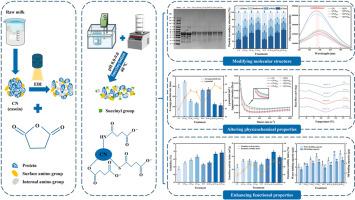绵羊酪蛋白的辐照协同琥珀酰化修饰:对理化性质、分子结构和功能性质的影响
IF 11
1区 农林科学
Q1 CHEMISTRY, APPLIED
引用次数: 0
摘要
本研究旨在采用多尺度分析方法系统表征电子束辐照和琥珀酸酐化学偶联对山羊酪蛋白理化性质、分子结构和功能性质的影响。EBI的琥珀酰化程度表明,EBI能有效地促进琥珀酰化反应,使得双重修饰比EBI或单独琥珀酰化对蛋白质的修饰效果更好。琥珀酰化程度的增加与酪蛋白理化性质和功能性质的显著变化相对应。酪蛋白的赖氨酸、β-sheet和游离巯基含量以及内源荧光强度和表面疏水性均显著降低。相比之下,β-turn含量显著增加,而分子柔韧性、热稳定性、粒径和绝对ζ-电位则表现出琥珀酰化处理的双相响应;最初的上升,随后的下降。蛋白质结构发生了从有序到无序的构象转变,表面呈现粗糙、疏松和多孔状态,溶解性、乳化性和水油结合能力得到改善。静态流变特性的结果显示琥珀酰化介导的蛋白质-蛋白质和蛋白质-水相互作用的改变,以及表观粘度和剪切应力的降低。同时,核磁共振(NMR)氢谱中新观察到的氢峰表明酪蛋白琥珀酰化成功。综上所述,本研究结果表明,EBI和琥珀酰化的协同作用可以显著改善酪蛋白的功能特性,为拓宽酪蛋白在食品加工中的应用提供了新的思路。本文章由计算机程序翻译,如有差异,请以英文原文为准。

Irradiation co-succinylation modification of caprine casein: Impact on physicochemical properties, molecular structure, and functional properties
This study aimed to systematically characterize the effects of electron beam irradiation (EBI) and succinic anhydride chemical conjugation on the physicochemical properties, molecular structure and functional properties of caprine casein employing multi-scale analytical approaches. The degree of succinylation achieved with EBI indicated effective promotion of the succinylation reaction, making the dual modification better for the protein than EBI or succinylation alone. The increase in succinylation degree corresponded to significant changes in the physicochemical and functional properties of casein. Notably, the lysine, β-sheet, and free sulfhydryl contents of casein, along with endogenous fluorescence intensity and surface hydrophobicity decreased significantly. In contrast, β-turn content markedly increased, while molecular flexibility, thermal stability, particle size, and absolute ζ-potential exhibited a biphasic response to succinylation treatment; an initial increase followed by a subsequent decline. Additionally, protein structures underwent a conformational transition from ordered to disordered, with the surface presenting a rough, loose, and porous state, and the solubility, emulsification properties, and water–oil binding ability showing improvement. The results of static rheological properties revealed succinylation-mediated alterations in the protein–protein and protein–water interactions, along with reduced apparent viscosity and shear stress. Concurrently, the newly observed hydrogen peak in the nuclear magnetic resonance (NMR) hydrogen spectrum indicated successful succinylation of casein. Altogether, the results of this study show that synergistic effects of EBI and succinylation can significantly improve the functional properties of casein, providing new insights into broadening its application in food processing.
求助全文
通过发布文献求助,成功后即可免费获取论文全文。
去求助
来源期刊

Food Hydrocolloids
工程技术-食品科技
CiteScore
19.90
自引率
14.00%
发文量
871
审稿时长
37 days
期刊介绍:
Food Hydrocolloids publishes original and innovative research focused on the characterization, functional properties, and applications of hydrocolloid materials used in food products. These hydrocolloids, defined as polysaccharides and proteins of commercial importance, are added to control aspects such as texture, stability, rheology, and sensory properties. The research's primary emphasis should be on the hydrocolloids themselves, with thorough descriptions of their source, nature, and physicochemical characteristics. Manuscripts are expected to clearly outline specific aims and objectives, include a fundamental discussion of research findings at the molecular level, and address the significance of the results. Studies on hydrocolloids in complex formulations should concentrate on their overall properties and mechanisms of action, while simple formulation development studies may not be considered for publication.
The main areas of interest are:
-Chemical and physicochemical characterisation
Thermal properties including glass transitions and conformational changes-
Rheological properties including viscosity, viscoelastic properties and gelation behaviour-
The influence on organoleptic properties-
Interfacial properties including stabilisation of dispersions, emulsions and foams-
Film forming properties with application to edible films and active packaging-
Encapsulation and controlled release of active compounds-
The influence on health including their role as dietary fibre-
Manipulation of hydrocolloid structure and functionality through chemical, biochemical and physical processes-
New hydrocolloids and hydrocolloid sources of commercial potential.
The Journal also publishes Review articles that provide an overview of the latest developments in topics of specific interest to researchers in this field of activity.
 求助内容:
求助内容: 应助结果提醒方式:
应助结果提醒方式:


